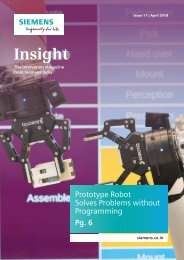Insight_PDF For Web
Create successful ePaper yourself
Turn your PDF publications into a flip-book with our unique Google optimized e-Paper software.
eEthylene: CO2-neutral Production<br />
In the government-funded<br />
eEthylen project, experts from<br />
Siemens are working together<br />
with scientists from Evonik,<br />
Berlin Technical University,<br />
Ruhr University Bochum, and<br />
the Helmholtz Institute<br />
Erlangen-Nuremberg to study<br />
how carbon dioxide can be<br />
converted into ethylene. “We<br />
are convinced that not only will<br />
CO2 help to produce coveted materials,<br />
but that it will also open up new business<br />
opportunities for Siemens,” says Dan<br />
Taroata, a project manager at Siemens,<br />
the consortium’s leader.<br />
The researchers are using electricity in a<br />
direct, single-stage electrolysis system to<br />
synthesize ethylene out of carbon dioxide<br />
and water. Their work focuses on<br />
electrocatalysts because these materials<br />
can charge inert CO2 with energy-rich<br />
electrons in order to create ethylene. If<br />
the electrons cluster in the surrounding<br />
water instead, the process creates<br />
hydrogen. That’s why the catalyst plays a<br />
decisive role in the method’s success.<br />
However, it is a great technological<br />
challenge to find a stable cupriferous<br />
electrode for the production of ethylene.<br />
Siemens researchers in the Rheticus research project are working to generate specialty chemicals from carbon dioxide. Elena Volkova is<br />
preparing electrodes, a cell, and a set of operating parameters for a new series of tests.<br />
Electrolyzers: A Core Area of Expertise at Siemens<br />
<strong>For</strong> the CO2-to-ethylene<br />
production process, Siemens is<br />
contributing a system from one<br />
of its key areas of expertise: an<br />
electrolysis facility for<br />
continuous operation. It is<br />
based on electrolyzers for<br />
hydrogen production, which<br />
are part of the company’s current product<br />
range.<br />
The three-year project, which was<br />
launched in October 2016, is receiving<br />
funding from the German Ministry of<br />
Education and Research and is part of the<br />
CO2Plus research initiative for the use of<br />
CO2 to broaden the production base for<br />
raw materials. Siemens is the leader of the<br />
project consortium. With a total budget of<br />
€2.9 million, the eEthylen project could<br />
revolutionize ethylene production. Its goal<br />
is to find out how carbon dioxide can be<br />
efficiently converted into ethylene.<br />
Economical Ethylene Production<br />
Ethylene is currently used in a<br />
wide variety of ways. <strong>For</strong> one<br />
thing, it is the feedstock for the<br />
production of polyethylene,<br />
polyvinylchloride, and<br />
polyester. As such, it is<br />
contained in most plastics.<br />
Ethylene also helps to make<br />
fruits and vegetables ripen at<br />
precisely the right time — an<br />
important application in a world of<br />
globalized food-supply chains.<br />
If the electrolytic production process can<br />
be optimized, it might be able to compete<br />
with the conventional manufacturing<br />
method. In addition to the fact that the<br />
process would use atmospheric CO2 and<br />
thus be desirable from an environmental<br />
perspective, it would also be worth<br />
pursuing from a business point of view.<br />
That’s because one ton of ethylene costs<br />
between €850 and €1,200 — a hefty sum,<br />
considering that around 180 million tons<br />
are used annually worldwide.<br />
• Ulrich Kreutzer<br />
Picture credits: Evonik<br />
Taken from Pictures of the Future, the Siemens<br />
Magazine for Research and Innovation<br />
<strong>For</strong> more information,<br />
write to insight.in@siemens.com<br />
5



